Device and Cloud Security¶
To ensure the security of the devices and data transmission, the device needs to be authenticated before exchanging data with the EnOS IoT Hub. EnOS supports Secret-based One-way Authentication and Certificate-based Two-way Authentication.
The overall authentication process for device connection is as follows:
Create a device in Asset Management > Device Asset .
Configure the device information for an EnOS Edge.
Connect the Edge to EnOS Cloud. The device authentication keys will be sent to EnOS cloud for authentication.
If the authentication succeeds, the device gets online and can communicate with EnOS cloud.
If the authentication fails, the connection is closed.
The specific flow chart is as follows:
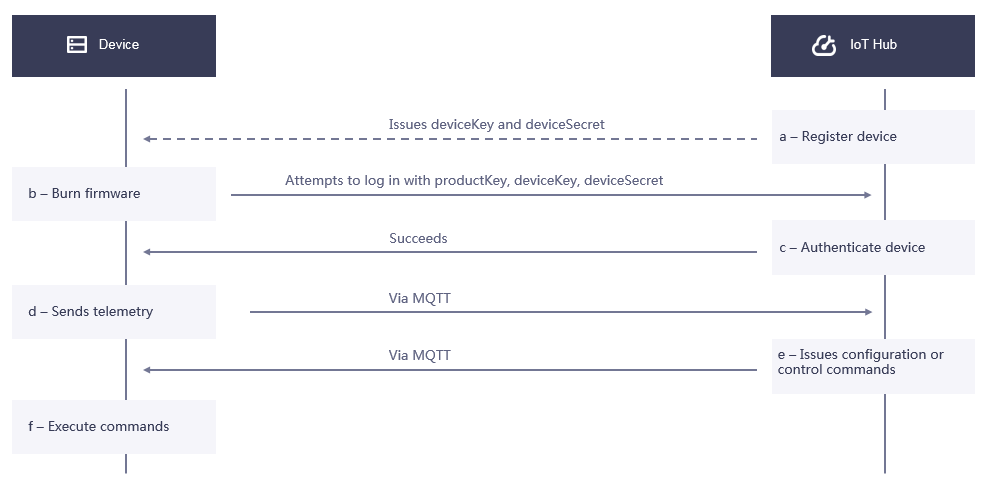
Secret-based Authentication¶
Secret-based authentication refers to the authentication of devices based on the authentication keys, i.e. the ProductKey, DeviceKey, and DeviceSecret.
Before going further with the secret-based authentication mechanism, it is recommended that you understand the following terms and concepts:
Product authentication pair:
ProductKeyandProductSecret.ProductKey: The global unique identifier issued by EnOS to the product.ProductSecret: The product secret issued by EnOS, which is paired withProductKey. It is used for the dynamic activation of devices. To initiate the dynamic activation, a device sends a request containing theProductKey,ProductSecret, andDeviceKeyto EnOS to get theDeviceSecretupon its first connection to EnOS.
Device authentication pair:
DeviceKeyandDeviceSecret.DeviceKey: A globally unique device identifier that is user-defined or auto-generated when a user registers a device on EnOS.DeviceSecret: The device secret issued by EnOS, which is paired withDeviceKey.
Device Authentication Operations¶
Perform the following operations in the following order to connect a device to EnOS.
Registration
Create a device instance in EnOS by either using the console or calling an API. The device will be in an Inactive state.
Authentication
You can either dynamically or statically authencitate a device. Once the device is authenticated, its state changes from Inactive to Online. If an Online device does not send any data to EnOS within the specified time range, it will become Offline.
Device Authentication Mode and Device States¶
You can dynamically or statically activate the device.
Dynamic Authentication: To use dynamic authentication, go to Asset Management > Product. Find the product that the device is created from and click View in the Operations column. In the Basic Information tab page, enable the Enable Dynamic Activation switch. The process of dynamic authentication is as follows:
After being created on EnOS, the device sends a request carrying the
ProductKey,ProductSecret, andDeviceKeyfor theDeviceSecret. If the authentication is successful, aDeviceSecretwill be returned to the device.The device tries to get authenticated with the
ProductKey,DeviceKey, andDeviceSecret.
Once the device has been authenticated, its status will change from Inactive to Online. The device will then be able to send data to EnOS. If no data is sent within a certain period of time, the status of the device will change to Offline.
Static Authentication: This is the default authentication method. Devices using this authentication method carry the
DeviceSecretgiven when created on EnOS, together with theProductKeyandProductSecret. The process of static authentication is as follows:The device sends an authentication request carrying the
ProductKey,DeviceKey, andDeviceSecret.Once the device is successfully authenticated, its status will change from Inactive to Online. The device will now be able to communicate with EnOS. If no data is sent within a certain period of time, the status of the device will be changed to Offline.
When the device is not working properly or you do not want to receive its data, set it to Disabled. The device will then go Offline.
Certificate-based Authentication¶
The secret-based authentication refers to device identity authentication with authentication keys. It is a one-way authentication mechanism, that is, the IoT Hub validates the identity of the device but the device does not verify the identity of the IoT Hub. To enforce two-way authentication, the certificate-based authentication mechanism can be used.
When certificate-based authentication is enabled, EnOS enforces the following security schemes to secure the connection between the EnOS Edge and EnOS IoT Hub.
The communication between the EnOS Edge and EnOS IoT Hub is based on certificate-based bi-directional authentication.
Supports the RSA algorithm to verify the signature and uses a 2048-bit RSA key.
Before going further with the certificate-based two-way authentication mechanism, it is recommended that you understand the following terms and concepts.
Certificate Authority (CA): An entity that issues digital certificates.
CA certificate: A digital certificate issued by the CA. It conforms to the certificate format defined by the IETF RFC 5280 specification.
Device certificates: The certificates signed and issued by the CA certificate owner. Device certificates are generated in the following process.
Authentication keys are generated when you create a device on EnOS.
A certificate signing request (CSR) is generated based on the authentication keys.
The CSR is sent to the CA.
The CA certificate signs and issues the device certificates and registers the device certificates in CA. Meanwhile, the device certificates are also stored in the devices.
X.509 Certificate Authentication¶
Setup Phase¶
The following diagram illustrates the process of secure communication between the edge and EnOS cloud based on X.509 certificate:
1. EnOS cloud acquires X.509 certificate
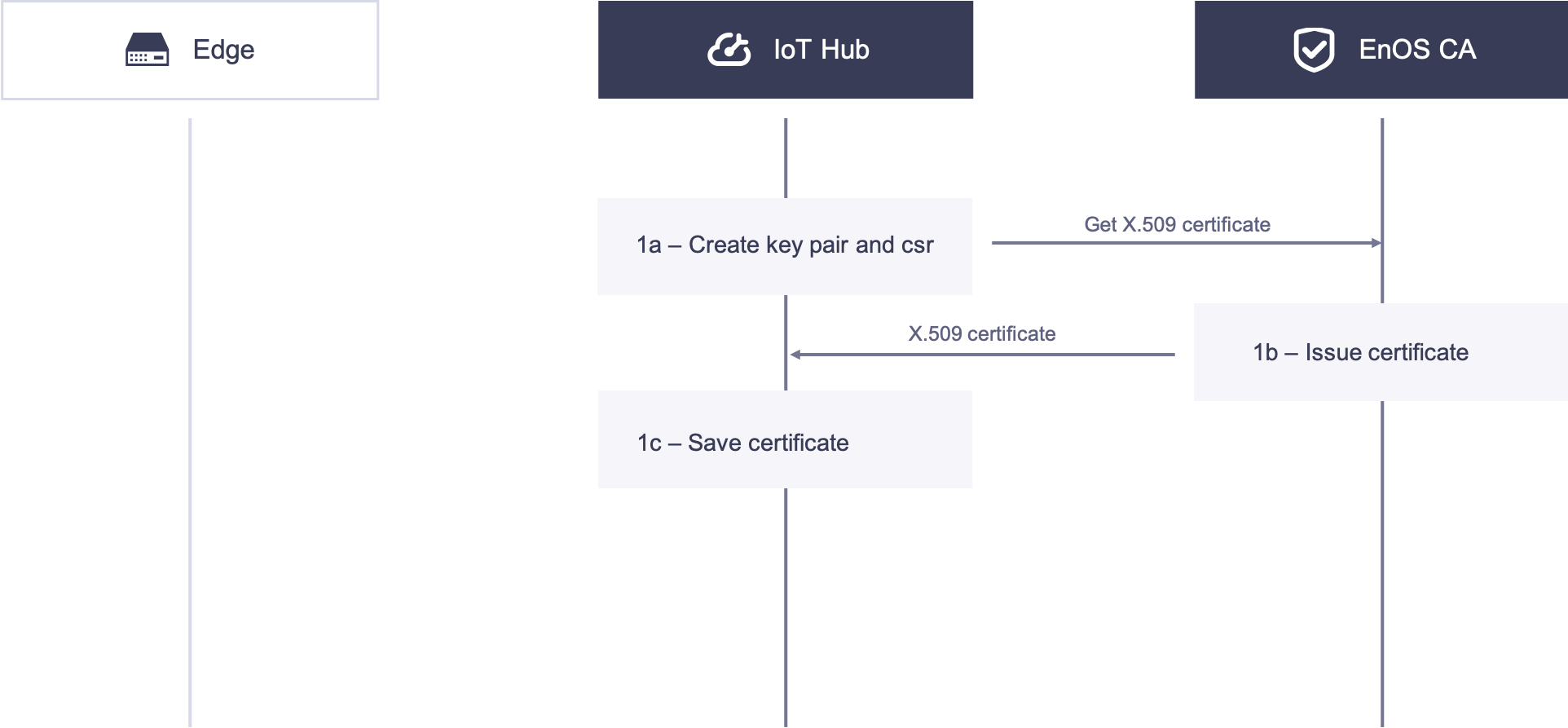
1a. EnOS Cloud the creates authentication keys and CSR locally, and acquires the X.509 certificate with the CSR by calling the X.509 certificate service API.
1b. The CA issues the X.509 certificate and sends the certificate to EnOS Cloud.
1c. EnOS Cloud receives and stores the X.509 certificate.
2. Edge acquires X.509 certificate
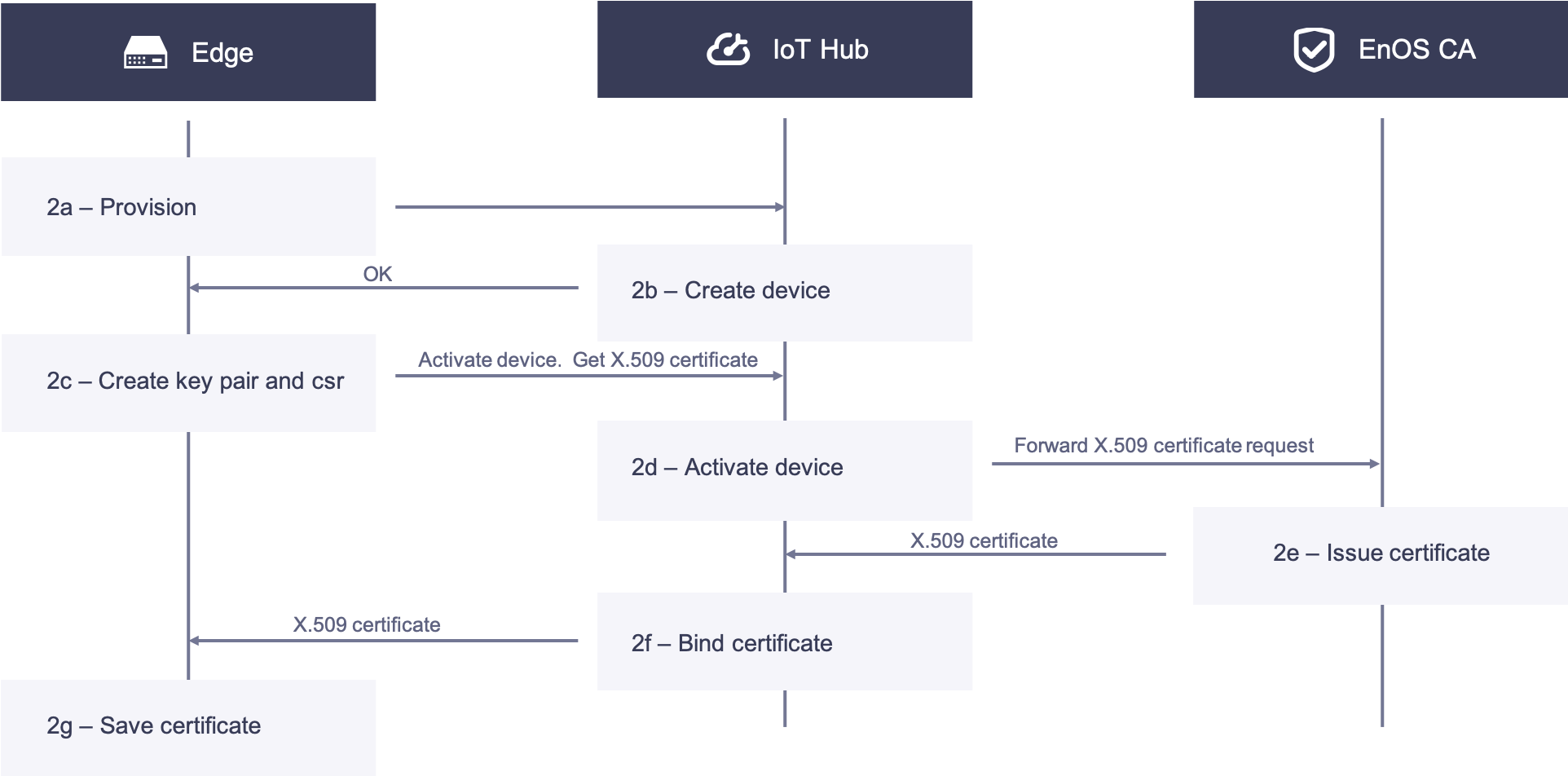
2a. Edge devices are pre-configured with the ProductKey, ProductSecret, and device serial number (SN) stored in themselves. When powered on and connected to the network, the Edge device reports its ProductKey, ProductSecret, and serial number to EnOS Cloud for dynamic activation. EnOS Cloud returns the DeviceSecret to Edge if the authentication is successful.
2b. On EnOS Cloud, the serial number of the Edge device is used as the DeviceKey to create the Edge device instance. The device can be created either on the EnOS Management Console or by calling the API.
2c. The Edge receives a response from EnOS Cloud, creates the authentication keys and CSR, and calls the API to obtain its X.509 certificate. Meanwhile, the device authentication keys are used to log the device in to the cloud, and the device will be activated upon its first successful login.
2d. EnOS Cloud receives the CSR. After verifying its identity, the CSR is forwarded to the CA.
2e. The CA receives the CSR, issues the edge certificate and sends the certificate to EnOS cloud.
2f. EnOS cloud receives the issued X.509 certificate, binds it with the device id, and then sends the edge certificate to the Edge.
2g. The edge receives the certificate and saves it locally in, for example, the Trusted Platform Module (TPM).
Communication Phase¶
3. Edge communicates with EnOS cloud, authenticated with X.509 certificate.
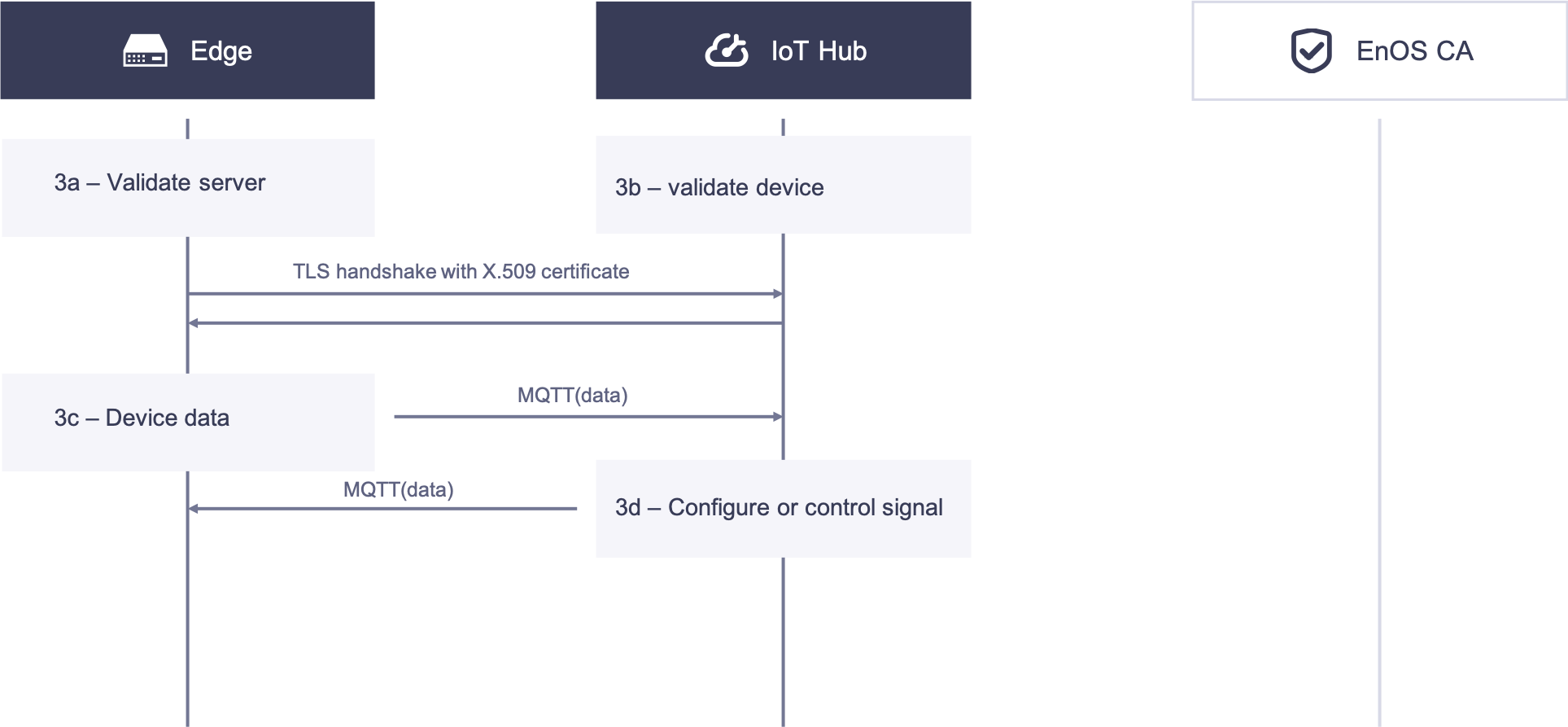
3a. The Edge validates the certificate of EnOS Cloud.
3b. EnOS Cloud validates the certificate of the Edge.
When authentication succeeds, connection is established between the Edge and EnOS cloud.
Certificate Revocation¶
In some scenarios, the user needs to revoke the X.509 certificate granted to the Edge. The following diagram illustrates the revocation process.
4. EnOS cloud revokes the X.509 certificate granted to Edge
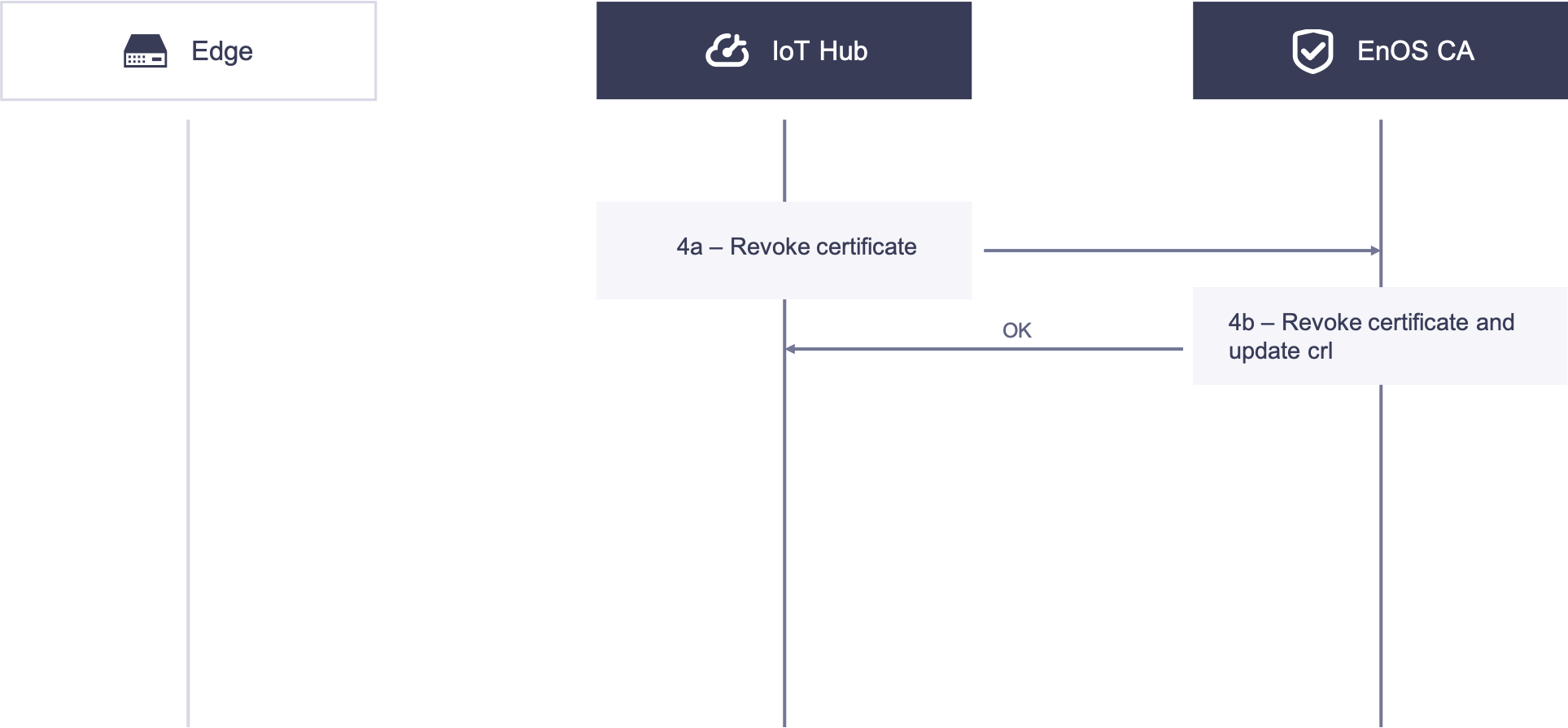
4a. EnOS calls an API to revoke the X.509 certificate.
4b. The CA receives the revoke request from EnOS Cloud, authenticates the request, revokes the certificate, and updates the CRL.
Edge Security Best Practices¶
In the certificate-based authentication, consider using the following best practices:
Create a private key for the Edge and keep it secret in a storage such as TPM.
Use TLS 1.2 when communicating with EnOS Cloud, and verify that the server certificate is valid.
Each Edge must have a unique public/private key pair.
The authentication keys used for authentication by EnOS Cloud should not be used for other purposes.
Revoke the authentication key when the Edge is reset.
Make sure your operating system on which the Edge runs is secured through certain mechanisms, for example, a firewall.
Ensure that you have a way to update the root certificates and CRL.
Ensure that the clock on the Edge is not tampered with.
Next Steps¶
EnOS enforces the secret-based authentication mechanism by default. The keys and secrets are generated or specified when you Create a Product and Create a Device.
When you enable the certificate-based authentication, you will need to use the certificate APIs to generate the device certificates as instructed in Quick Start: Securing Connection Through Certificate-Based Authentication (Java) to establish a secure connection between the devices and IoT Hub.